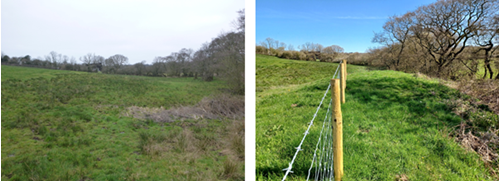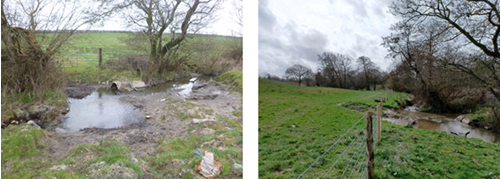Small changes by farmers can make a BIG difference for our rivers

The Four Rivers for LIFE is the latest EU LIFE funded river restoration project led by Natural Resources Wales. It aims to improve the condition of four major rivers in south Wales: the Teifi, Cleddau, Tywi and Usk.
Here Robert Thomas, Four Rivers for LIFE Land Management Officer talks about the work he’s been doing with the help of a farmer along a tributary of the river Teifi.
We all love rivers, and we all want them to be healthier and over the next few years our project will work with various groups to help improve the condition of our rivers.
Farmers form one such group and an integral one at that. All four river catchments can be found flowing through mostly rural landscapes with agriculture accounting for the majority of the land use in close proximity to the rivers.
So, this is why it’s so important for us to work closely with farmers and the farming community. The project hopes to offer funding and opportunities that will maintain the productivity of the farms, while also continuing to protect the natural environment.
What does the land management team do and why?
As part of the Four Rivers for LIFE Project there are four Land Management Officers in total, and we all have a river that we focus on.
As a team, our work predominantly looks to work closely with farmers providing advice and funding about sustainable farming techniques and emerging best practice, as well as having an eye on improving conservation and ecology of the rivers.
Our rivers offer a huge range of benefits. These include use for business, public water supply and recreation – all of it relying on a high-water quality that also provides important homes for rare wildlife and plants.
The project is an opportunity to deliver real improvements on the ground during the lifetime of the project.
My work largely focuses on the river Teifi and recently I have been out on the Afon Hirwaun which is a tributary of the river Teifi.
A survey by Natural Resources Wales in 2020 identified the Hirwaun as requiring interventions to improve water quality due to nutrient and sediment run off from nearby farms.
What does a farm visit entail?
Over recent months I have been visiting farms along the river Teifi and setting up visits where I can speak to farmers and offer face to face advice.
The visit involves a look around the farmyard, river bank and fields taking notes and photos to capture the practices and land uses of the holding, to help me understand how the farm interacts with the river.
This information is then written up in a brief report which I then share with the farmer and discuss some of the options and areas where I think they might be able to benefit from advice or funding for infrastructure work.
For our project, ‘infrastructure work’ means methods like fencing and creating buffer strips along riverbanks, planting trees that offer bank stability as well as shading benefits for fish.
These solutions are sometimes referred to as ‘nature-based solutions’ where we look at natural methods to help the ecological quality of the rivers to improve accessibility for migratory fish, habitat structure and function, and water quality.
We also advise and can offer funding support on farmyard infrastructure improvements such as installing guttering along roofs to help improve clean and dirty water separation, with the aim of reducing pressures on slurry stores.
The focus for our project is on environmental improvements on farmland and riverbanks. In this case the aim was to support the farmer and ensure the productivity of the farm, whilst at the same time keeping the Afon Hirwaun healthy and reducing the opportunity for nutrients and slurry to enter it.
Why are nutrients and slurry bad for the rivers?
Fertilisers that are spread on crops to help them grow are classed as nutrients, and slurry comes from the manure of livestock.
When either of these enter rivers they can have a major detrimental effect, such as discoloration and enrichment, which has a significant impact on the wildlife and plants that live in and around the river.
By entering our rivers, nutrients and slurry strip oxygen from the water, suffocating and killing most river life; this impact continues as they descend down tributaries to main rivers.
What has the project done so far on the Afon Hirwaun?
From my visit to Fron Farm that is located along the Hirwaun, there were two main issues: livestock accessing the river and causing bank erosion as well as animal faeces entering the river.
Firstly, we proposed to install fencing along the watercourse with the aim of excluding livestock and reducing the risk of bank erosion. Below are before and after images of some of the work that has been carried out.


We generally advise that fencing should be installed at a minimum of two metres to a maximum of 10 metres from the riverbank. This creates a buffer strip where, if suitable, trees and hedges can be planted to help stabilise the banks.
To install the fencing, we worked with local contractors who used tracked machines to ensure that the machines caused no compaction or damage to the fields.
Secondly, we also proposed to reduce the livestock crossing points through the river from two to one. This would significantly reduce the amount of animal faeces entering the river.
This option was agreed with the farmer and the images below show one of the crossing points that was fenced off. We are now looking at options of installing a bridge or bottomless culvert at the existing crossing point to prevent all livestock faeces from entering the river.

Thanks to the agreement and support from the farmer, we have succeeded in creating a riverside corridor approximately 914 metres in length along this stretch of the Hirwaun.
We hope in time, these solutions will significantly reduce bank erosion and animal faeces entering the river, which in turn will encourage wildlife back to the Hirwaun and help improve the quality of the main river Teifi.
All the solutions mentioned in this article have been funded by the Four Rivers for LIFE project.
If you farm along the Teifi, Tywi, Cleddau or Usk river catchments and want to know more about these opportunities please get in touch by emailing 4RiversforLIFE@cyfoethnaturiolcymru.gov.uk
